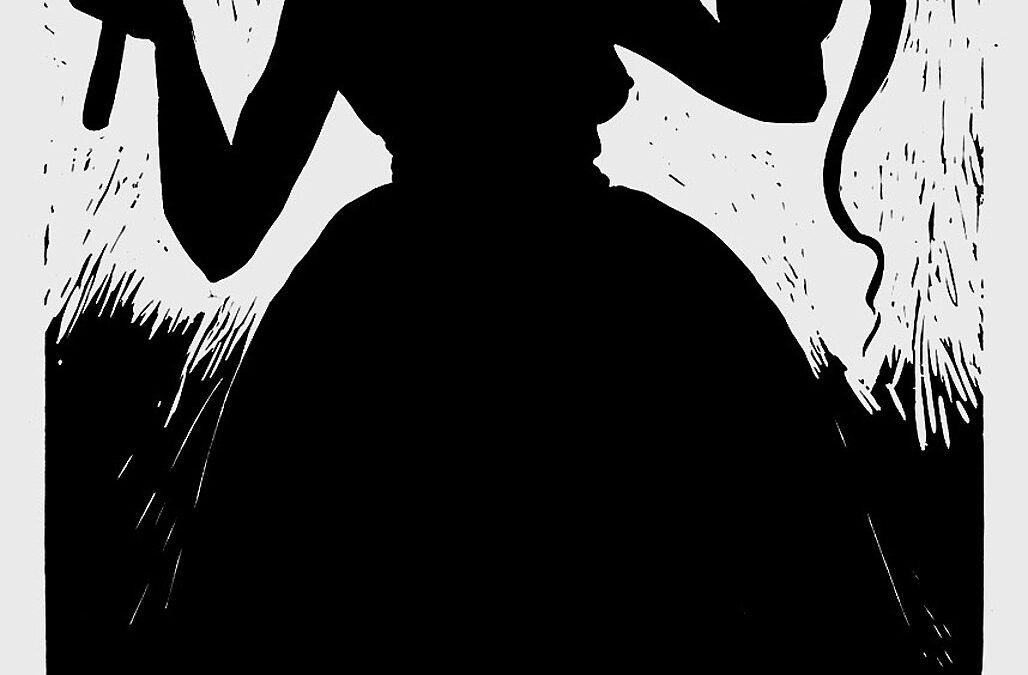Kara Walker (American, b. 1969). Boo-hoo (for Parkett no. 59), edition PP 5/6, 2000. Linocut, 40 x 20 1/2 in. (101.6 x 52.1 cm). Collections of Jordan D. Schnitzer and His Family Foundation, 2003.13. © Kara Walker
By Betsy DiJulio
Kara Walker’s reputation as one of the most important artists working today is undisputed. Her self-proclaimed uneasy relationship with her own imagination is similarly solidified.
Walker is best known for ambiguous, but hard-hitting, tableaux rendered in her iconic large scale black paper silhouettes, a reinterpretation of the popular 18th and 19th century cut-paper craft. This artist, whose bright penetrating light was recognized at the age of 24 with her first major show at the Drawing Center in New York, continues to burn brightly. And I do mean burn.
It’s tricky territory, hers. When an artist chooses to dwell in the realm of hateful racial stereotypes—feeding the noise back loud if you will—the intended irony is lost on some. And when those 19th C. black stereotypes such as pickaninnies, minstrels, and other visual tropes are the chief actors in narratives and disparate interactions—truths woven together with fictions and self-described exaggerations—about brutalities from slavery to sexual violence and other forms of exploitation and physical abuse, the terrain becomes a minefield.
Created between 1994 and 2019, the 83 works in this exhibition are from the collections of the Jordan D. Schnitzer Family Foundation. Representing the artist’s prodigious output in a range of media—prints, sculpture, film, and more—the exhibition originated at the Frist Museum of Art in Nashville. There it was co-curated by then Executive Director, Susan H. Edwards, Ph.D., and Ciona Rouse, the latter of whom is also serving as co-curator with Heather Hakimzadeh for the exhibition’s run at MOCA.
A student of history, literature, and popular culture, Walker’s work is extensively researched and poetically rendered, filtered through her personal experiences and identity as a Black woman. Rouse, who is a Nashville-based poet, shared that in a recent interview, Walker referred to herself as a “painter-poet.” Likening a close visual read of the work to reading poetry, Rouse asserts that “We first feel language in our bodies.” And the initial reaction to Walker’s work is likely to be visceral while leaving viewers with more questions than answers.
One of the key questions that resides at the heart of the exhibition is stated by Edwards in her catalogue essay, “Can provoking discomfort, disgust, tension, and anxiety explode stereotypes and set us on a more equitable and just path?” To help answer that question—and others about identity, values, power, prejudices, colonialism, and imperialism—both Rouse and Hakimzadeh applaud the Programming Committee who has been meeting since last summer to craft a series of community conversations and events that Hakimzadeh describes as “extremely robust.” Though there are no trigger warnings, per se—“Art is triggering—walking into a museum is the trigger,” says Rouse—it is recommended that parents view the exhibition first and make a determination about the appropriateness for their own children.
Noting that Hampton Roads is “entangled” with the history of slavery, e.g. the documented beginning of chattel slavery in what would become the United States has been traced to Point Comfort in Hampton, Hakimzadeh feels that MOCA is “a wonderful place to have this discourse.” Everyone, she asserts, “should sit with” the exhibition content and “find their place in it,” embracing the discomfort…even those who think they are “dialed in,” as she previously did.
From Rouse’s perspective, the exhibition and its attendant programming, from the Hold Space Place curated by Get Well Soon to the ever innovative and fresh ArtLab, asks viewers to synthesize the past and present into a way forward. But for those who align more with the “put the art in a room and turn on the lights…I’ll do the thinking on my own” stance of my friend, who formerly worked at MOMA in NYC, the lights will be on through June 11.
On view concurrently is LaToya M. Hobbs: Flourish, a portrait-based tribute to the matriarchs of her community. Based in Baltimore where she is a professor at the Maryland Institute College of Art, Hobbs earned her MFA from Perdue University and has gone on to create work collected by the likes of the Metropolitan Museum of Art. In her mixed-media portraits, the artist fuses painting with the carving that characterizes relief printmaking into a practice that, through its “subtractive” aspects, serves as a metaphor for the need of Black women to shed negative beliefs and stereotypes in order to allow a positive, beautiful, and authentic image to emerge. Here, as in much of the best contemporary art, the process of creation—carving, collaging, and painting—is inextricably linked to content.
WANT TO SEE?
Kara Walker: Cut to the Quick
from the Collections of Jordan D. Schnitzer and His Family Foundation
Through June 11
Virginia MOCA




